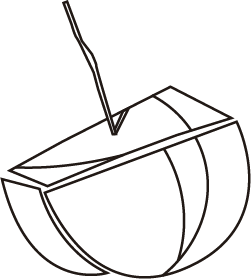The abandoned villages
Of the twenty-one villages that La Vall de Gallinera had at its peak during medieval times, only eight are currently inhabited.
In La Vall de Gallinera it is possible to visit the remains of three of these farmhouses (or villages) originating in the Muslim and Moorish periods that gradually became abandoned settlements: L’Alcúdia, Benimarsoc and La Solana de Benissili.
L'Alcúdia
The farmhouse called L’Alcúdia was first documented in a written text in 1369, in Llibre de la col·lecta del morabatí de les valls de Gallinera i Ebo. The name comes from the Arabic al-kúdya, “the hill”.
It is located on a small projection of land halfway between Benirrama and Benialí, near the old royal road, which nowadays is called Camí de L’Alcúdia in that point.
Remains of houses can still be seen today, as stone enclosures with various heights, some of which now serve as walls for the terraced fields. The walls of the church, which was dedicated to Saint Mary Magdalene, also stand in fairly good conditions. Near the abandoned village there is the spring of L’Alcúdia, with a pond that collects the water that once irrigated the village’s vegetable gardens.
People lived in L’Alcúdia until 1880.











Benimarsoc
The abandoned village of Benimarsoc was first mentioned in a written document in 1286. The place name comes from the Arabic Banû Marzûq, the name of the Berber group that created the first farmhouse.
The last houses were abandoned in 1920 and from then on the village began a process of deterioration that has left behind very few remains. It should be clarified that, although the original farmhouses date back to Muslim times, the ruins that remain belong to the modern houses built by the Mallorcan settlers and their descendants.
La Solaneta de Benissili
Closing the westernmost exit of the valley, very close to the spring of La Mata, stand the remains of the farmhouse of La Solana de Benissili, which was studied by Josep Torró and Josep Ivars. It is noteworthy that the original name has not yet been found in any document, so it is known by the place name of the site where it is located.
The only information available is provided by the building remains that can still be seen and the ceramic fragments from the 13th and 14th centuries that were found in the surrounding terraced fields. The various walls that can be seen were all parts of a single house, the floor area of which has almost completely been preserved, although rehabilitated and extended by later interventions.
The existence of this farmhouse must have been relatively short and most likely it disappeared during the 15th century, or even earlier.







